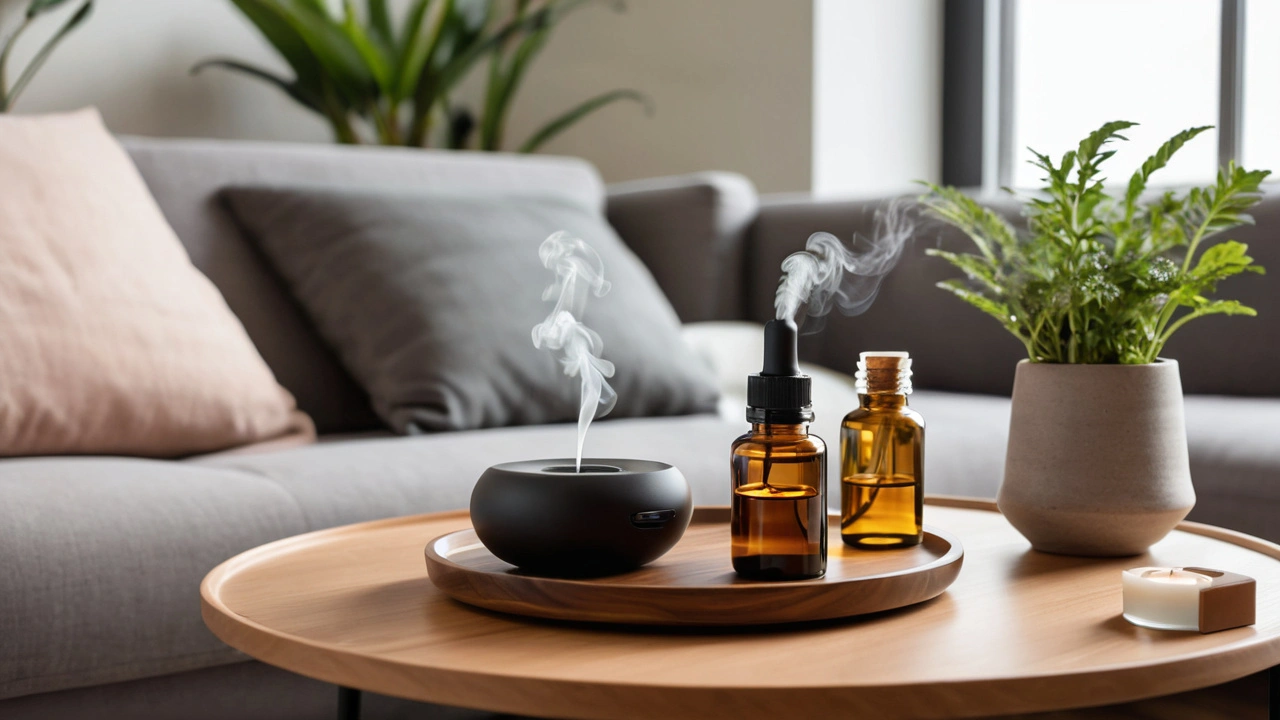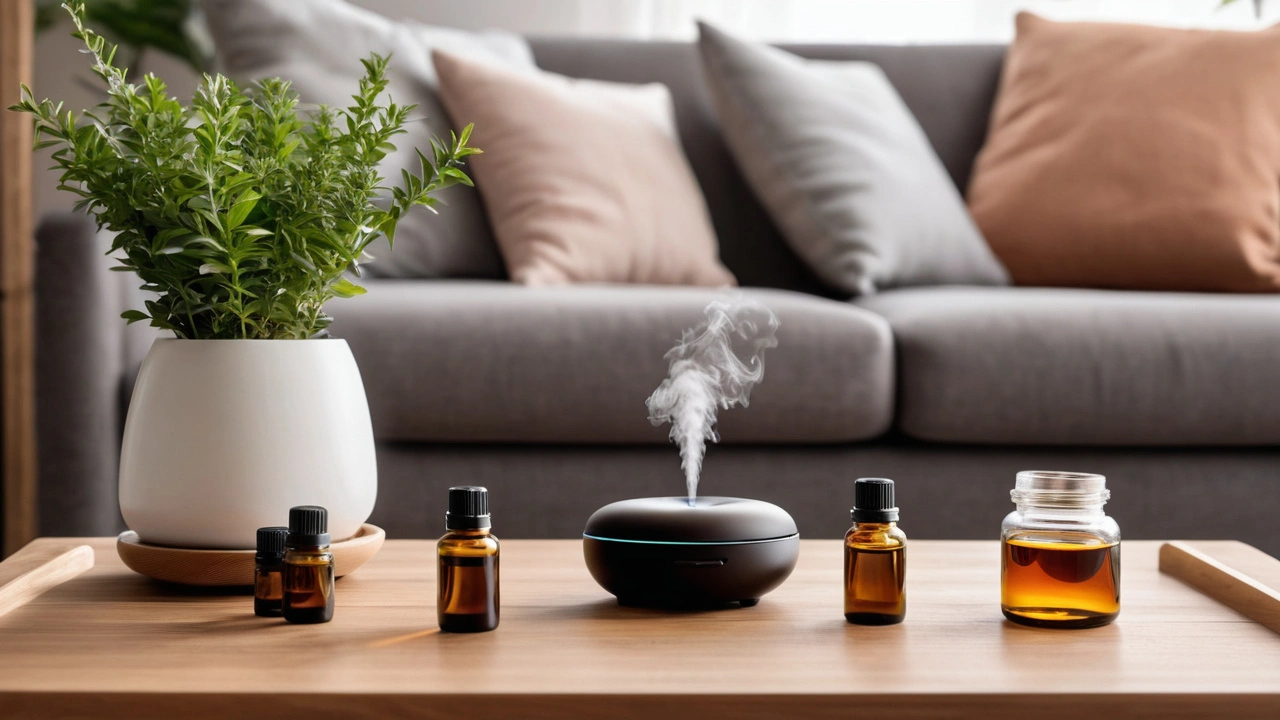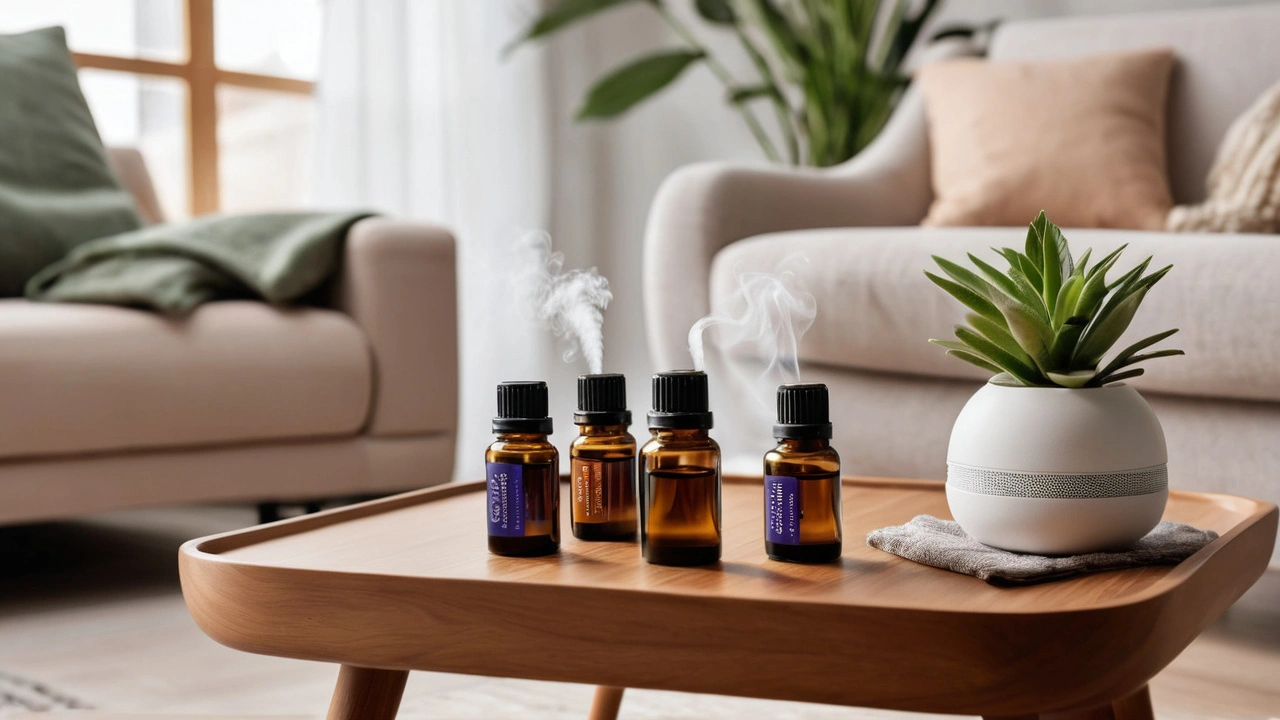Aromatherapy is gaining popularity as more people seek natural ways to improve their well-being. The practice involves using essential oils extracted from plants to promote physical and emotional health. In 2022, this ancient art has been evolving with new trends, making it more accessible and effective.
One of the standout developments is the use of lesser-known essential oils. While lavender and peppermint remain favorites, oils like blue tansy and helichrysum are making waves for their unique benefits. Tech advancements also play a role, with smart diffusers and apps that allow precise control over your aromatic environment.
Mental wellness takes center stage too. Essential oils are used to manage stress, anxiety, and sleep disorders, helping to create a balanced state of mind. The focus is not just on what oils you use, but how you use them, making aromatherapy more personalized and impactful.
Sustainability is another key trend, with a move towards ethically sourced oils and eco-friendly packaging. This ensures that your wellness routine supports environmental health as well.
DIY enthusiasts are exploring homemade blends and remedies, making aromatherapy more hands-on and customizable. Finally, combining aromatherapy with other wellness practices, such as yoga and meditation, amplifies the benefits, creating a holistic approach to health.
- The Rise of Uncommon Essential Oils
- Tech Meets Aromatherapy
- Focus on Mental Wellness
- Sustainability in Aromatherapy
- DIY Aromatherapy Remedies
- Combining Aromatherapy with Other Wellness Practices
The Rise of Uncommon Essential Oils
Aromatherapy has long been associated with familiar scents like lavender, peppermint, and eucalyptus. However, 2022 has marked a shift towards exploring lesser-known essential oils, giving enthusiasts new options to experiment with. This movement is driven by the desire to discover unique benefits offered by these less conventional oils and to diversify the aromatic experience.
One such oil making its mark is blue tansy. Known for its vibrant blue color and calming properties, blue tansy is derived from a Mediterranean plant. It is often used to soothe irritated skin and reduce inflammation. Apart from its skin benefits, blue tansy also helps with stress management, offering a sweet, herbaceous scent that promotes relaxation.
Another oil gaining popularity is helichrysum, also known as the 'Everlasting' or 'Immortal' flower. This oil has profound regenerative properties and is frequently used in skincare to reduce the appearance of scars and wrinkles. Its anti-inflammatory and antioxidant properties make it a potent addition to any aromatherapy collection.
A standout in the realm of uncommon essential oils is ravintsara. Originating from Madagascar, this oil is often confused with ravensara but boasts its own unique benefits. Ravintsara is prized for its antiviral and respiratory support properties. It has a fresh, clean scent that is perfect for diffusing during cold and flu season, providing both an aromatic and protective shield against illnesses.
"The exploration of these rare essential oils not only broadens our sensory palette but also opens doors to new therapeutic practices," notes Dr. Jane Buckle, author of 'Clinical Aromatherapy: Essential Oils in Healthcare'.
When it comes to integrating these uncommon oils into daily routines, it's essential to understand their specific uses and benefits. For instance, blue tansy and helichrysum can be incorporated into skincare routines by adding a few drops to your regular moisturizer or creating a custom facial oil blend. Ravintsara can be diffused in living spaces to purify the air or added to steam inhalations for respiratory relief.
Additionally, blenders are finding creative ways to combine these unique oils with more familiar ones. A blend of blue tansy, lavender, and chamomile, for example, can create a potent anti-stress cocktail. Similarly, helichrysum can be mixed with frankincense and rose to create an anti-aging serum that nourishes and protects the skin.
The rise of uncommon essential oils is not just a trend but an exciting evolution in the field of aromatherapy. As we continue to explore the vast world of plant essences, these rare oils offer new horizons for both wellness enthusiasts and novices alike. The expanding repertoire allows for more personalized and effective aromatic experiences, catering to specific needs and preferences.
Tech Meets Aromatherapy
In 2022, as technology advances at an unprecedented pace, it's no surprise that it has also found its way into the world of aromatherapy. The fusion of cutting-edge technology with this ancient practice has opened up new horizons and created a more efficient and effective experience for enthusiasts. One of the most exciting developments in this area is the rise of smart diffusers. These devices not only disperse essential oils into the air but also connect to your smartphone, allowing you to customize and control your environment with just a few taps. You can set schedules, adjust diffusion levels, and even blend different oils according to your needs and preferences.
Another noteworthy innovation is the development of aromatherapy apps. These applications provide users with tailored recommendations based on their mood, health concerns, or desired outcomes. They offer guided meditations, breathing exercises, and even track your progress over time. This synergy between tech and wellness helps users better understand and manage their emotional and physical well-being. For those who are new to aromatherapy, such apps can serve as an excellent introduction, offering a wealth of information and practical tips.
Wearable technology is also making significant strides in the field of aromatherapy. Products such as essential oil-infused jewelry and portable diffusers allow individuals to carry the benefits of aromatherapy with them throughout the day. These devices are designed to be stylish and discreet while providing a continuous release of essential oils, helping to reduce stress and improve concentration.
According to Dr. Joshua Levitt, a naturopathic physician and wellness expert, 'The integration of technology into aromatherapy not only enhances its accessibility but also maximizes its therapeutic potential.' This combination allows people to make the most out of their aromatherapy practice by personalizing it to fit their lifestyle and needs.
Furthermore, advancements in AI and machine learning are shaping the future of aromatherapy. AI-powered devices can analyze a user's environment and suggest the most suitable essential oils for their specific conditions. These intelligent systems consider factors like room size, humidity levels, and personal preferences to create a perfectly balanced aromatic experience. Companies are also exploring the use of AI in developing new essential oil blends, ensuring they are optimized for efficacy and safety.
The overall shift towards smart home ecosystems is another trend worth mentioning. Integrating aromatherapy diffusers with home automation systems allows users to create a holistic wellness environment. For example, diffusers can be programmed to release relaxing scents as part of a bedtime routine or energizing aromas in the morning. This synchronized approach can help reinforce healthy habits and contribute to a more balanced lifestyle.
In essence, the convergence of technology and aromatherapy brings a host of benefits. From increased convenience and customization to enhanced therapeutic effects, these innovations are revolutionizing the way we experience and engage with aromatherapy. As we move forward, it's exciting to imagine what new advancements will emerge, further solidifying the bond between tech and wellness.

Focus on Mental Wellness
The increasing pressures of modern life have led many to search for effective methods to manage stress and promote mental well-being. Aromatherapy has emerged as a popular choice due to its natural approach and easy integration into daily routines. Essential oils, such as lavender, chamomile, and bergamot, are known for their calming properties, helping to alleviate anxiety and improve mood.
A fascinating aspect of aromatherapy is its impact on the brain. When inhaled, essential oils stimulate the olfactory system, directly influencing the limbic system, which is responsible for emotions and memory. This connection explains why certain aromas can evoke powerful emotional responses and foster a sense of peace. For example, lavender oil has been shown to lower levels of cortisol, the stress hormone, leading to a state of relaxation.
Research supports the efficacy of essential oils in mental health care. A study published in the Journal of Clinical Psychopharmacology found that patients who received aromatherapy with lavender oil experienced a significant reduction in anxiety levels compared to those who received a placebo.
"Aromatherapy using lavender oil can be an effective complementary therapy for anxiety and stress," noted Dr. Jane Buckle, a leading expert in clinical aromatherapy.Such findings highlight the potential of aromatherapy as a non-invasive supplement to traditional treatments.
Incorporating aromatherapy into mental wellness routines can be straightforward yet impactful. Diffusion is a popular method, where essential oils are dispersed through the air using a diffuser. This creates a soothing environment, ideal for meditation or unwinding after a long day. For those on the go, portable options like roll-ons or inhalers offer a quick way to access the benefits of essential oils. Applying diluted oils to pulse points, such as the wrists or temples, can provide a calming effect throughout the day.
Personalization plays a crucial role in maximizing the benefits of aromatherapy. Each individual may react differently to various scents, so it's important to experiment and find what works best for you. Blending oils to create a custom mix can enhance effectiveness. For example, combining lavender with bergamot can provide a balanced blend that soothes anxiety while uplifting the spirit.
Beyond personal use, aromatherapy is being integrated into settings like workplaces, schools, and therapy sessions. Creating an aromatic environment can enhance focus, reduce tension, and promote a positive atmosphere. Schools have started to introduce essential oils like rosemary, known for its cognitive benefits, to help students stay alert and improve memory retention during study sessions.
In summary, the integration of aromatherapy into mental wellness routines is a simple yet powerful way to support emotional well-being. By choosing the right oils and application methods, individuals can tailor their experience to meet their unique needs. As research continues to explore the benefits of essential oils, aromatherapy stands out as a promising tool for fostering mental health in a natural and accessible manner.
Sustainability in Aromatherapy
As the world becomes more aware of environmental issues, **sustainability** in aromatherapy has emerged as a significant trend. Many consumers now seek products that not only benefit their well-being but also respect and protect the environment. This shift is encouraging companies to adopt eco-friendly practices and source their essential oils ethically.
One of the primary concerns is the over-harvesting of certain plants used in essential oils, like sandalwood and frankincense. Sustainable farming practices and wildcrafting guidelines are now in place to ensure these plants are harvested responsibly. Some companies partner with local farmers and communities to ensure ethical and sustainable production, providing fair wages and maintaining the local ecosystem.
Packaging also plays a vital role in sustainability. More brands are switching to recyclable and biodegradable materials to reduce their carbon footprint. Glass bottles, minimalist packaging, and the reduction of plastic use are steps being taken to make aromatherapy products more environmentally friendly. Refilling stations for essential oils are also gaining traction, allowing customers to refill their bottles instead of buying new ones.
The commitment to sustainability extends to the production process itself. Companies are investing in green energy, reducing water usage, and ensuring that their manufacturing processes have minimal environmental impact. Transparency is crucial here, as consumers want to know the origins of their products and the methods used to make them.
Education is another aspect of sustainability. Brands are educating consumers on the importance of using essential oils responsibly. They offer guidance on proper dilution techniques and safe usage to prevent overuse and wastage. The emphasis is on quality over quantity, encouraging mindful consumption.
An inspiring example comes from the brand doTERRA, which sources its essential oils through a network of sustainable farms across the globe. They focus on co-impact sourcing, ensuring that local communities benefit from the trade. According to doTERRA, this model helps

DIY Aromatherapy Remedies
Creating your own aromatherapy remedies at home can be an empowering and deeply satisfying experience. Not only does it give you control over the quality of the ingredients you use, but it also allows you to tailor blends specifically to your needs. So, let's dive into the wonderful world of DIY aromatherapy, where creativity meets well-being.
One of the joys of making your own remedies is the ability to experiment with different essential oils and their properties. For example, lavender is celebrated for its calming effects, while eucalyptus is known to clear respiratory passages. Imagine blending these to create a soothing yet invigorating balm for those challenging winter months. The first step is usually knowing what you aim to achieve, be it relaxation, invigoration, or mood enhancement.
An easy and popular remedy to start with is a homemade diffuser blend. It's amazing how a few drops can transform an entire room's atmosphere. Mix 3 drops of lavender, 3 drops of cedarwood, and 2 drops of wild orange in your diffuser with water. This combination can help reduce stress and increase focus, making it perfect for your home office or study space. Essential oils like eucalyptus and peppermint are great for a refreshing morning blend.
Another simple DIY project is creating personalized roll-on oils. These are convenient and portable, perfect for on-the-go aromatherapy. Combine 10 drops of your favorite essential oil with a carrier oil like jojoba or coconut oil in a 10ml roller bottle. For instance, a mixture of frankincense for grounding and lavender for calming can be a wonderful companion during stressful days. These blends can offer instant relief wherever you are.
If skincare is your focus, crafting your own facial oils can be a game-changer. Mix a tablespoon of jojoba oil with a few drops of tea tree oil for an acne-fighting serum. Or, for a more anti-aging formula, blend rosehip seed oil with frankincense and a touch of vitamin E oil. Treating your skin with natural products free from chemicals can lead to beautiful results.
"The best part of DIY aromatherapy is the personalized touch it brings to your wellness routine." - Holistic Health Journal
Bath salts are another beloved remedy. They are easy to make and can be tailored to your preference. For a relaxing soak, mix one cup of Epsom salt with 10 drops of lavender and chamomile. You can also try a detoxifying blend with Himalayan salt, grapefruit oil, and juniper berry oil. These salts can be stored in jars and make lovely gifts as well.
Aromatherapy can also extend to cleaning products. Homemade cleaners not only smell amazing but are also free from harsh chemicals. A few drops of lemon and tea tree oil in a spray bottle with water and vinegar can serve as an effective all-purpose cleaner. These natural alternatives make your home smell wonderful while ensuring it is safe and non-toxic.
Now, let's not forget about the pets! Essential oils like lavender and chamomile can be used in diluted form to help calm anxious animals. A spray made from distilled water and a drop or two of lavender oil can be lightly misted around their bedding (but never directly on them) to create a more serene environment.
Ultimately, DIY aromatherapy remedies provide a sense of accomplishment and a deeper connection to your wellness practices. From diffuser blends to luxurious bath salts, the possibilities are endless. By experimenting with different oils and methods, you can create unique blends that cater to your personal needs and preferences. This hands-on approach not only benefits your health but also encourages a more mindful and involved way of living.
Combining Aromatherapy with Other Wellness Practices
Blending aromatherapy with other wellness practices can enhance their effects, creating a more balanced and harmonious routine. Integrating essential oils into activities like yoga, meditation, or even your morning workout can have a profound impact on your physical and mental well-being.
Yoga and aromatherapy make a perfect pair. Essential oils can set the mood for a calming yoga session, helping to deepen your practice. Consider using lavender or frankincense in a diffuser before you start. These oils promote relaxation and can help you achieve a more meditative state. During your session, you might apply a diluted blend of peppermint oil to your temples to invigorate and focus your mind.
Meditation is another practice that pairs well with aromatherapy. Scents like sandalwood and cedarwood are known for their grounding properties. They can help you maintain focus and deepen your meditative state. Just a drop or two on your wrist or the use of a diffuser can create a serene environment that supports your meditation goals.
Jane Buckle, PhD, RN, author of 'Clinical Aromatherapy,' notes, "Aromas can play a significant role in emotional health and meditation practices."
Another emerging trend is combining aromatherapy with physical workouts. Using invigorating oils like eucalyptus or citrus in your gym space can energize you, helping you push through your routines. Many people find that these scents enhance their motivation, leading to more effective workouts.
Aromatherapy can also complement your sleep hygiene practices. Lavender and chamomile oils are famous for their calming effects, aiding in better sleep. By incorporating these oils into your nightly routine either through massages or diffusers, you can improve the quality of your rest and wake up feeling refreshed.
If you’re into journaling or mindful reading, consider using oils like rosemary to enhance concentration and focus. These practices, when combined with suitable aromatherapy, can make your experiences more fulfilling and impactful.
Practical Tips for Combining Aromatherapy
There are various ways to incorporate aromatherapy into your wellness practices:
- Diffusion: Use an essential oil diffuser to disperse your chosen oils into the air.
- Topical Application: Dilute essential oils with a carrier oil and apply to your skin.
- Inhalation: Add a few drops to a handkerchief and inhale deeply.
- Bath Time: Add essential oils to your bath for a relaxing experience.
By thoughtfully combining aromatherapy with your wellness habits, you can amplify the benefits, creating a more holistic approach to health and well-being. The integration of these practices can lead to improved physical and mental health, making each day a little more balanced and serene.
